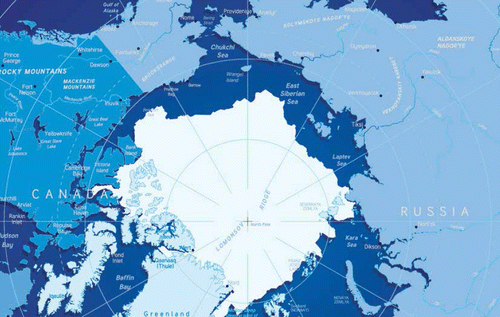Abstract
The Fourth International Symposium on “Alien Species in the Holarctic” was convened September 22–28, 2013, by the Russian Academy of Sciences at the I.D. Papanin Institute for the Biology of Inland Waters (IBIW) on the Volga River in Borok (∼355 km north of Moscow). The Organizing Committee spanned five countries (France, People's Republic of China, Poland, Russian Federation, and the United States), with participants (n=150) across the breadth and depth of the Russian Federation, from countries in proximity to it (i.e., Armenia, Lithuania, Kazakhstan, Kyrgyzstan, Ukraine, Siberia, and The Republic of China), and more globally from the United States to Tasmania and Norway to South Africa. This report provides a synopsis of invasive species issues that were discussed at the symposium and, as such, provides an international window for the evaluation of fisheries-related topics in this part of the globe.
The human-mediated introduction of organisms into areas outside of their potential ranges (as defined by natural dispersal and biogeographic barriers) is a distinct branch of science termed “invasion ecology” (CitationDavis 2009; CitationLockwood et al. 2009). It was first developed by CitationElton (1958) as a means to imbed life histories and population ecologies of invasive species within the context of conservation and management. Additional early efforts (CitationLaycock 1966) established to the lay public the extensive economic and conservation harm that can be produced by such introductions. However, as a discipline, invasion ecology is not without controversy. Much of it is due to a clock that has oscillated between slower and faster manifestations. For example, invasion ecology clearly has historic roots long associated with human dispersal, particularly within regions such as the Holarctic, where continental landmasses are interconnected and biodiversity can be easily transported. Such a perspective lends credence to contrarian arguments that biological invasions are not unique or contemporaneous, and thus to develop a specialized discipline for its study may be a bit abstruse (CitationDavis 2009; CitationValéry et al. 2013). Other disagreements (CitationDavis et al. 2011) focus not on invasives as one pole in the “indigenous-alien” spectrum, but rather in the context of “damages wrought,” with a rejoinder (CitationSimberloff 2011a) that impacts may not be manifested ecosystem-wide until decades following innocuous introductions (CitationCrooks 2005; see below Amur Sleeper Perccottus glenii). In this sense, counter-arguments suggest that invasives should be considered “guilty until proven innocent” (CitationRicciardi and Simberloff 2009; CitationSimberloff 2011b).
A more contemporary aspect of invasion ecology, and hence its potential timeliness as a discipline, has been the enormous increase in species now considered invasive. Numbers have increased exponentially since 1975 (CitationRichardson and Pyšek 2008) due largely to globalization of trade (CitationMeyerson and Mooney 2007) and a concomitant laxity with regard to the dissemination of biodiversity (CitationHulme 2009). The end result is that already-established invasives have become even more mobile (see below Rainbow Trout Oncorhynchus mykiss), whereas those that lack a history of invasiveness (Amur Sleeper and Pumpkinseed Lepomis gibbosus) are establishing the rudiments of a global network. This process has become so provocative that invasive species are now viewed as a major threat to national security (CitationRichardson et al. 2011), due largely to the substantial economic and ecological damages they produce (CitationRicciardi et al. 2011). Furthermore, the severity of the situation is rapidly accelerating due to the effects of global climate change (CitationRahel and Olden 2008), an aspect that magnifies the invasive threat. In this sense, and importantly for the Holarctic, climate change has altered its topography by reducing and mobilizing perennial sea ice so as to generate different economic and environmental opportunities, such as new navigational routes (e.g., Northwest and Northeast passages), resource extraction, oceanic productivity, tourism, and wildlife management.
Interestingly, the upsurge in numbers of invasive species has occurred in lockstep with increasing human life expectancy and per capita gross domestic product (GDP) (CitationLotz and Allen 2013). This means that while countries modernize with regard to their social structures, they also become excruciatingly more vulnerable to the establishment and proliferation of invasive species, and those with higher percentages of invasive and endangered species also reflect lower ecosystem resilience (i.e., disturbance that can be absorbed before changes in structure and control of a system are altered). And as the populace extends its life expectancy, disproportionately larger (and more negative) ecological and carbon footprints are produced and more natural resources concomitantly mobilized. The admonition “live long and prosper” does have its downsides. These aspects are discussed below in the context of an economic infrastructure that supports and sustains invasive species.
Dire as the increasing extent and complexity of invasive species issues seemingly are, one could still pose the question, “How damaging has the impact of invasive species been to native biodiversity?” Preliminary statistics are startling. The Invasive Species Specialist Group (ISSG) of the International Union for the Conservation of Nature (IUCN) reports that some 1,159 species have potentially gone extinct since tracking began, while an additional 22% of vertebrates, 41% of invertebrates, and 70% of plant species propelled into “endangered” status (CitationVié et al. 2009). The rank of an invasive within the predator-prey hierarchy is the causative agent for provocative environmental and economic damages, particularly when compared to native predators (CitationPaolucci et al. 2013). In this sense, invaders that insert within higher trophic levels clearly have more severe impacts, deemed as a top-down consumer control of ecosystem regulation (CitationSax and Gaines 2008). These data underscore the fact that invasive species, and their historic and contemporary repercussions, form a burgeoning scientific discipline with roots in conservation and management.
In recognition of these aspects, the Fourth International Symposium on “Invasion of Alien Species in Holarctic” was convened by the Russian Academy of Sciences, from September 22–28, 2013, at the I.D. Papanin Institute for the Biology of Inland Waters (IBIW) on the Volga River in Borok, 355 km north of Moscow (). The institute is renowned as a research center for freshwater ecology and, with the A. N. Severtsov Institute of Ecology and Evolution (Moscow), served as intellectual focus for the symposium. Presenters underscored the fact that the enormous growth of trade and the advancement of technologies that facilitate travel have clearly promoted invasive species translocations (CitationMinchin and Gollasch 2002), not only across large oceans but into freshwater rivers as well (CitationSlynko et al. 2002). The release of ballast water from large oceanic tankers was repeatedly recognized as an issue promoting the transportation and dissemination of marine invasives (CitationGollasch et al. 2002; CitationRothlisberger et al. 2012), yet proposed solutions vary globally. An initial approach has been to require either ballast water exchange or saltwater flushing (i.e., replacing ballast water with open ocean water), but both have obvious limitations.
Figure 1. Motif of the Fourth International Symposium on “Invasion of Alien Species in Holarctic,” Russian Academy of Sciences, I.D. Papanin Institute for the Biology of Inland Waters, Borok, Russian Federation.
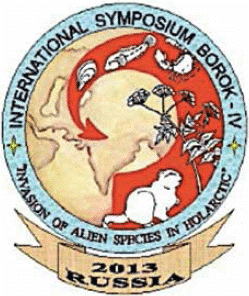
Thus, the iterative take-home message heard at the symposium was a request to agree on new legislation so as to better regulate the dumping of ballast (see also 2013 articles in the section “Managing Ballast Water Discharges” Ecological Applications 23(2):287–351; esajournals.org/toc/ecap/23/2).
Others in the symposium stressed the extraordinary development of invasion ecology in the past 20 years by demonstrating its breadth and depth as well as its involvement in the environmental and political milieu. In addition, comprehensive ecological data sets coupled with hardware and software innovations have opened new avenues of data amalgamation and analyses () that, in turn, have broadened and extended the field (e.g., CitationOlenin et al. 2013). Yet, invasion ecology is largely recognized as an applied discipline that still struggles to develop successful conservation and management policies as a mechanism to quell unregulated invasions. Numerous case studies in the symposium indeed reported on the invasive problem “after the fact” (i.e., from a reactive stance), with monitoring programs serving as early warning systems and with subsequent management actions emphasizing control and eradication ().
However, the opportunity to conduct natural experiments that yield data on real-time ecological and evolutionary phenomena (per CitationSax et al. 2007) was an aspect other practitioners acknowledged. For example, predicting and thus preventing invasions by a priori deciphering their dynamics, particularly in a changing climate, would be proactive approaches that utilize ecological theory as a basis for research. Similarly, a focus on the manner by which anthropogenic modifications of aquatic ecosystems have facilitated the invasion process would also be proactive, but from a management stance. These, in turn, could transform invasion ecology from a “crisis discipline” similar to that of “conservation biology,” to one that both predicts and adaptively manages alien species and their impacts (CitationRicciardi et al. 2013). These approaches could be employed, for example, to model the occurrence and extent of a predicted North American invasion by Amur Sleeper, a fish currently invasive to Eurasia (CitationReshetnikov and Ficetola 2011; CitationUSFWS 2012).
Figure 2. Front page of an integrated information system on aquatic non-indigenous and cryptogenic species, AquaNIS (corpi.ku.lt/databases/aquanis). Although developed to store biological invasion data from European and neighboring regional seas, AquaNIS has the capacity to accommodate information from other global marine and freshwaters.
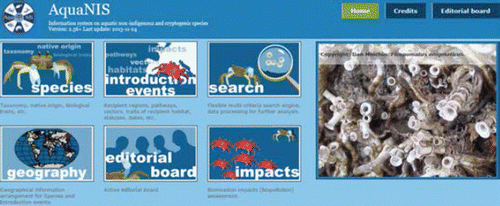
Many at the conference argued that molecular methods are but one of the more promising approaches that could advance the discipline. Hybridization (CitationSimberloff 2006) and habitat homogenization (CitationOlden et al. 2007), for example, promote genetic swamping via introgression (CitationEchelle and Conner 1989), with species extinction an end result. Despite the success of molecular methods in elucidating evolutionary and ecological mechanisms, only a few tests can be effectively employed in invasive ecology. This is largely due to the short and contemporary timescales over which invasions have most often occurred, and which in turn limit the numbers and types of applicable tests. These might include: (a) identifying the geographic origin of an invasive, (b) evaluating potential bottlenecks, and (c) assaying for potential hybridization with native species (CitationFitzpatrick et al. 2012). However, molecular approaches are rapidly expanding, and new tests are now being devised and revised. For example, the population structure of an invasive species in its native range has been found to correlate negatively with geographic spread in its introduced range (CitationGaither et al. 2013). This offers a mechanism to quantify which invasive is likely to become widespread once established. It can also provide a firm scientific basis from which policy makers can establish management priorities.
Figure 3. Left: Russian fisheries biologists setting a net on the Tsimljansky Reservoir; Right: Dmitry A. Vekhov with invasive Silver Carp Hypophthalmichthys molitrix caught in Tsimljansky Reservoir. Photo credits: Dmitry A. Vekho.
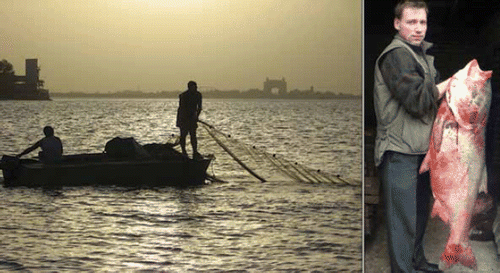
An interesting intellectual twist for North American participants was a focus on Nearctic species that have now become serious aquatic invasives elsewhere in the globe, specifically the Palearctic. A classic but largely unappreciated example is Rainbow Trout, a native of the North American Pacific Rim that subsequently dispersed during Late Pleistocene to the Kamchatka Peninsula of the Russian Federation (CitationBehnke 1992). It is now globally invasive and seriously problematic (CitationHalvorsen 2010), with a long history of deliberate recreational stocking, accidental aquaculture escapes, and/or illegal introduction (CitationLeprieur et al. 2008). The end results are strong impacts on endemic freshwater systems.
A Global Invasive Species Database (issg.org) maintained by the Invasive Species Specialist Group (ISSG) of the World Conservation Union (IUCN) highlights eight fishes among the “World's Worst 100 Invasive Alien Species” (CitationLowe et al. 2004). Three of these are introduced solely for sport, with the poster child being Rainbow Trout, now found in more than 90 countries (CitationCasal 2006). As a successful invader, it has precipitated two distinct but parallel effects. First, it disturbs ecological interactions among indigenous species, with displacement through competition and predation (CitationSimberloff et al. 2013; Table 1). It concomitantly alters a shared aquatic invertebrate community as well (CitationJoseph et al. 2011). These impacts are greatest in places where other salmonids have not been distributed historically (e.g., Australia and New Zealand). In the Southern Hemisphere, exotic salmonids are the most abundant freshwater fish and have caused widespread ecological damage (CitationConsuegra et al. 2011). In Germany, Rainbow Trout is also the most widespread of introduced fishes with 5,872 records in open waters, and it represents the largest commercial inland fishery with >21,000 tons annual yield (CitationWolter and Röhr 2010).
The second negative aspect for Rainbow Trout is that it is a component of a global consumer society (CitationOlden et al. 2005) within which recreation is deemed more important than conservation (CitationCambray 2003). This rings especially true given associated expenses relating to fishing gear, specialty magazines, and the infrastructure of food and accommodations, all of which can promote economic growth and GDP (as previously noted), yet to the detriment of the environment. The question then becomes whether a country can divest itself of a positive economic component despite its negative effects on endemic biodiversity. While an answer is not immediately apparent, its formulation is not favorably disposed towards biodiversity conservation (see ).
Figure 4. Some endemic fishes of European Russia are relatively immune to non-anthropogenic predation when at adult size. One of these is the Wels Catfish Siluris glanis, as netted in the Tsimljansky Reservoir. It is primarily found in deeper waters of larger rivers, but grows to very large size near dams in reservoirs, yet is harvested as food. Photo credits: Dmitry A. Vekhov.
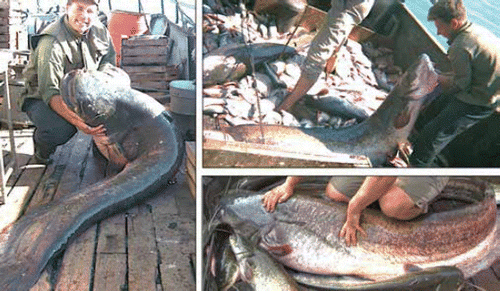
Figure 5. Left: Fishes caught by Russian fishery biologists documenting the first case of the alien species Amur Sleeper Perccottus glenii in Tsimljansky Reservoir (on the River Don in the Volgograd region). The Amur Sleeper is the dark predator in the center of the pail. The three fish immediately above are Gibel Carp Carassius auratus, another alien species; the curved fish immediately below is Northern Pike Esox lucius, a native predator, while the three fish with red eyes below the Pike are Roach Rutilus rutilus; Right: Amur Sleeper (top) with Northern Pike (3 individuals below) along with aquatic vegetation at site of capture. Photo credits: Dmitry A. Vekhov.
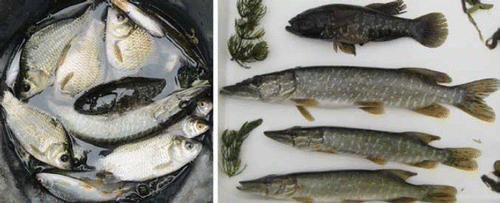
A second Nearctic invasive, a warm-water centrarchid (the Pumpkinseed), was first introduced into Europe circa 1885 (CitationHolcik 1991) and is now established in at least 28 European countries (CitationCucherousset et al. 2009). It is one (of two) aquatic species considered “very invasive” in Europe (CitationGarcia-Berthou et al. 2005) with greatest impacts within the Iberian Peninsula, whereas those in more northern European ecosystems are still being evaluated (CitationFobert et al. 2011). One aspect of its natural history, and the Centrarchidae in general, is an elevated phenotypic polymorphism in both native and introduced ranges. For example, considerable morphological variance is found among littoral versus pelagic and lake versus stream dwelling sunfish (CitationYonekura et al. 2007; CitationBhagat et al. 2011). This provides considerable ecological latitude when freshwater niches somewhat novel to their life histories become occupied. Another important aspect that seemingly has manifested itself with Pumpkinseed is the capacity for introduced forms to remain relatively inconspicuous for extended periods within novel habitats before they quickly spread and become invasive (CitationSimberloff 2011b).
North American participants in the symposium were also made aware of the dangers stemming from an invasive fish (the Amus Sleeper [Odontobutidae], also termed the Rotan or Chinese Sleeper), that has spread westward into Europe from far eastern Asia (, left). It is a relatively small (25 cm TL) voracious predator of ponds, oxbow lakes, temporally isolated flood plains, and other low-oxygenated lentic water bodies of the Amur River basin (the border between the Russian Far East and northeastern China). Its large gape and broad dietary proclivities, coupled with high reproductive output, are natural history attributes that in tandem have operated to severely depress densities of fishes, macroinvertebrates, and amphibians within its introduced range. During high water levels, the Amur Sleeper is often transported from adjacent oxbows and flood plains into the dispersal corridors of larger rivers (CitationReshetnikov 2013). It has become widely distributed in European Russia since 1916 (CitationReshetnikov 2004) and has now spread westward as far as Bavaria (CitationReshetnikov and Schliewen 2013). One concern is that global climate change will promote the long-term range dynamics of this invasive (CitationReshetnikov 2013) with the probability that in the coming decades it will substantially transform freshwater ecosystems of Western Europe (, right). The most troubling aspect for conservation biologists in the Nearctic is that bioclimatic suitability analyses underscore suitable habitat for the Amur Sleeper within North American aquatic systems, particularly those in Great Lakes but also the Mountain West (CitationReshetnikov and Ficetola 2011: ).
The symposium concluded with a wide-ranging roundtable discussion that touched upon many of the points articulated above (see CitationRichardson and Ricciardi 2013). For example, several participants pointed to the similarities that exist between restoring ecosystems to historic conditions, a common conservation theme, and one that seeks their maintenance free of invasive species. At odds with each is the practical recognition that nature no longer remains untouched by anthropogenic activities, particularly given changes in the global climate. Another prominent aspect of this discussion involved the accelerated spread of invasives in manifestly greater numbers than recorded historically, and via invasion pathways fundamentally distinct from those deemed non-anthropogenic and thus natural. A recurring theme was not only “how to accommodate” but more appropriately, “should we?” (CitationSimberloff 2013).
Symposium participants with a managerial background acknowledged that a more applied stance may be a potential handicap for the discipline, but also that the methodical process of monitoring has provided the baseline data necessary to fully grasp the impacts of invasives. For example, we now know that invasives unequivocally impact ecosystem functioning, both singly as well as in synergy with other anthropogenic impacts (CitationStrayer 2012). Thus, the trenchant differences between opposing positions (as previously noted) are clearly philosophical rather than data-driven and will not be easily adjudicated, either with regards to conservation biology or invasion ecology (per CitationSimberloff 2012). For sure, modified ecosystems are more the norm rather than the exception, and agencies and NGOs must react accordingly. Yet relinquishing a protocol that promotes the control and potential removal of invasives will do little to sustain natural ecosystems and the indigenous biodiversity that promotes their functioning (CitationStrayer et al. 2006). A baseline for managing and thus predicting invasions will require carefully controlled, empirical data, and these fall within the bailiwick of methodical and regimented monitoring. Given this, the two arguments may not be as distant as their written rhetoric would depict. It will be interesting to gauge whether philosophical distances expand or contract as the region moves towards the Fifth International Symposium on “Alien Species in the Holarctic.”
REFERENCES
- Behnke, R. J. 1992. Native trout of western North America. American Fisheries Society, Monograph 6, Bethesda, Maryland.
- Bhagat, Y., C. C. Wilson, M. G. Fox, and M. T. Ferreira. 2011. Genetic relationships among Pumpkinseed (Lepomis gibbosus) ecomorphs in freshwater reservoirs of Portugal. Ecology of Freshwater Fish 20: 287–298.
- Cambray, J. A. 2003. Impact on indigenous species biodiversity caused by the globalization of alien recreational freshwater fisheries. Hydrobiologia 500: 217–230.
- Casal, C. 2006. Global documentation of fish introductions: the growing crisis and recommendations for action. Biological Invasions 8: 3–11.
- Consuegra, S., N. Phillips, G. Gajardo, and C. Garcia de Leaniz. 2011. Winning the invasion roulette: escapes from fish farms increase admixture and facilitate establishment of non-native rainbow trout. Evolutionary Applications 4: 660–671.
- Crooks, J. A. 2005. Lag times and exotic species: the ecology and management of biological invasions in slow-motion. Ecoscience 12: 316–329.
- Cucherousset, J., G. H. Copp, M. G. Fox, E. Sterud, H. H. van Kleef, H. Verreycken, and E. Záhorská. 2009. Life-history traits and potential invasiveness of introduced Pumpkinseed Lepomis gibbosus populations in northwestern Europe. Biological Invasions 11: 2171–2180.
- Davis, M. A. 2009. Invasion biology. Oxford University Press, Oxford, UK.
- Davis, M. A., M. K. Chew, R. J. Hobbs, A. E. Lugo, J. J. Ewel, G. J. Vermeij, J. H. Brown, M. L. Rosenzweig, M. R. Gardener, S. P. Carroll, K. Thompson, S. T. A. Pickett, J. C. Stromberg, P. Del Tredici, K. N. Suding, J. G. Ehrenfeld, J. P. Grime, J. Mascaro, and J. C. Briggs. 2011. Don't judge species on their origins. Nature 474: 153–154.
- Echelle, A. A., and P. J. Connor. 1989. Rapid, geographically extensive genetic introgression after secondary contact between two pupfish species (Cyprinodon, Cyprinodontidae). Evolution 43: 717–727.
- Elton, C. S. 1958. The ecology of invasions by animals and plants. Methuen, London.
- Fitzpatrick, B. M., J. A. Fordyce, M. L. Niemiller, and R. G. Reynolds. 2012. What can DNA tell us about biological invasions? Biological Invasions 14: 245–253.
- Fobert, E. M., G. Fox, M. Ridgway, and G. H. Copp. 2011. Heated competition: how climate change will affect non-native Pumpkinseed Lepomis gibbosus and native Perch Perca fluviatilis interactions in the U.K. Journal of Fish Biology 79: 1592–1607.
- Gaither, M. R., R. W. Bowen, and R. J. Toonen. 2013. Population structure in the native range predicts the spread of introduced marine species. Proceedings of the Royal Society B 280(1760): 20130409. doi: 10.1098/rspb.2013.0409.
- García-Berthou, E., C. Alcaraz, Q. Pou-Rovira, L. Zamora, G. Coend-ers, and C. Feo. 2005. Introduction pathways and establishment rates of invasive aquatic species in Europe. Canadian Journal of Fisheries and Aquatic Sciences 62: 453–463.
- Gollasch, S., E. MacDonald, S. Belson, H. Bonen, J. T. Christensen, J. P. Hamer, G. Houvenaghel, A. Jelmert, I. Lucas, D. Masson, T. Mc-Collin, S. Olenin, A. Persson, I. Wallentinus. 2002. Life in ballast tanks. Pages 217–231 in E. Leppäkoski, S. Gollasch, and S. Olenin, editors. Invasive aquatic species of Europe. Distribution, impacts and management. Springer Science, Dordrecht, Netherlands.
- Halvorsen, A. 2010. An entirely synthetic fish: how Rainbow Trout beguiled America and overran the world. Yale University Press, New Haven, Connecticut.
- Holčík, J. 1991. Fish introductions in Europe with particular reference to its central and eastern part. Canadian Journal of Fisheries and Aquatic Sciences 48: 13–23.
- Hulme, P. E. 2009. Trade, transport and trouble: managing invasive species pathways in an era of globalization. Journal of Applied Ecology 46: 10–18.
- Joseph, M. B., J. Piovia-Scott, S. P. Lawler, and K. L. Pope. 2011. Indirect effects of introduced trout on Cascades frogs Rana cas-cadae via shared aquatic prey. Freshwater Biology 56: 828–838.
- Laycock, G. 1966. The alien animals. The Natural History Press, Garden City, New Jersey.
- Leprieur, F., O. Beauchard, S. Blanchet, T. Oberdorff, and S. Brosse. 2008. Fish invasions in the world's river systems: when natural processes are blurred by human activities. PLoS Biology 6: 404–410.
- Lockwood, J., M. Hoopes, and M. Marchetti. 2009. Invasion ecology. Wiley-Blackwell, Malden, Massachusetts.
- Lotz, A., and C. R. Allen. 2013. Social-ecological predictors of global invasions and extinctions. Ecology and Society [online serial] 18(3): 15. doi: 10.5751/ES-05550-180315.
- Lowe S., M. Browne, S. Boudjelas, and M. De Poorter. 2004. 100 of the world's worst invasive alien species. A selection from the Global Invasive Species Database. The Invasive Species Specialist Group (ISSG), World Conservation Union (IUCN). Available: issg.org/database/species/reference_files/100English.pdf (November 2013).
- Meyerson, L. A., and H. A. Mooney. 2007. Invasive alien species in an era of globalization. Frontiers in Ecology and the Environment 5: 199–208.
- Minchin, D., and S. Gollasch. 2002. Vectors - how exotics get around. Pages 183–192 in E. Leppäkoski, S. Gollasch, and S. Olenin, editors. Invasive aquatic species of Europe. Distribution, impacts and management. Springer Science, Dordrecht, Netherlands.
- Olden, J. D., M. E. Douglas, and M. R. Douglas. 2005. The human dimensions of biotic homogenization. Conservation Biology 19: 2036–2038.
- Olden, J. D., Z. S. Hogan, and M. J. Vander Zanden. 2007. Small fish, big fish, red fish, blue fish: size-biased extinction risk of the world's freshwater and marine fishes. Global Ecology and Biogeography 16: 694–701.
- Olenin S., A. Narščius, D. Minchin, M. David, B. Galil, S. Gollasch, A. Marchini, A. Occhipinti-Ambrogi, H. Ojaveer, and A. Zaiko. 2013. Making non-indigenous species information systems practical for management and useful for research: an aquatic perspective. Biological Conservation 173: 98–107. doi: 10.1016/j.bio-con.2013.07.040.
- Paolucci, E. M., H. J. MacIsaac, and A. Ricciardi. 2013. Origin matters: alien consumers inflict greater damage on prey populations than do native consumers. Diversity and Distributions 19: 988–995.
- Rahel, F. J., and J. D. Olden. 2008. Assessing the effects of climate change on aquatic invasive species. Conservation Biology 22: 521–533.
- Reshetnikov, A. N. 2004. The fish Perccottus glenii: history of introduction to western regions of Eurasia. Hydrobiologia 522: 349–350.
- Reshetnikov, A. N. 2013. Spatio-temporal dynamics of the expansion of Rotan Perccottus glenii from west-Ukrainian center of distribution and consequences for European freshwater ecosystems. Aquatic Invasions 8: 193–206.
- Reshetnikov, A. N., and G. F. Ficetola. 2011. Potential range of the invasive fish Rotan Perccottus glenii in the Holarctic. Biological Invasions 13: 2967–2980.
- Reshetnikov, A. N., and U. K. Schliewen. 2013. First record of the invasive alien fish Rotan Perccottus glenii Dybowski, 1877 (Odontobutidae) in the Upper Danube drainage (Bavaria, Germany). Journal of Applied Ichthyology 29 (6): 1367–1369.
- Ricciardi, A., and D. Simberloff. 2009. Assisted colonization is not a viable conservation strategy. Trends in Ecology and Evolution 24: 248–253.
- Ricciardi, A., M. E. Palmer, and N. D. Yan. 2011. Should biological invasions be managed as natural disasters? Bioscience 61: 312–317.
- Ricciardi, A., M. F. Hoopes, M. P. Marchetti, and J. L. Lockwood. 2013. Progress toward understanding the ecological impacts of non-native species. Ecological Monographs 83: 263–282.
- Richardson D. M., and P. Pysek. 2008. Fifty years of invasion ecology - the legacy of Charles Elton. Diversity and Distributions 14: 161–168.
- Richardson, D. M., P. Pysek, and J. T. Carlton. 2011. A compendium of essential concepts and terminology in invasion ecology. Pages 409–419 in D. M. Richardson, editor. Fifty years of invasion ecology: The legacy of Charles Elton. Wiley-Blackwell, Oxford, UK.
- Richardson, D. M., and A. Ricciardi. 2013. Misleading criticisms of invasion science: A field guide. Diversity and Distributions 19: 1461–1467.
- Rothlisberger, J. D., D. C. Finnoff, R. M. Cooke, and D. M. Lodge. 2012. Ship-borne nonindigenous species diminish Great Lakes ecosystem services. Ecosystems 15: 462–476.
- Sax, D. F., and S. D. Gaines. 2008. Species invasions and extinction: The future of native biodiversity on islands. Proceedings of the National Academy of Sciences 105: 11490–11497.
- Sax, D. F., J. J. Stachowicz, J. H. Brown, J. F. Bruno, M. N. Dawson, S. D. Gaines, R. K. Grosberg, A. Hastings, R. D. Holt, M. M. Mayfield, M. I. O'Connor, and W. R. Rice. 2007. Ecological and evolutionary insights from species invasions. Trends in Ecology and Evolution 22: 465–471.
- Simberloff, D. 2006. Hybridization between native and introduced wildlife species: importance for conservation. Wildlife Biology 2: 143–150.
- Simberloff, D. 2011a. Non-natives: 141 scientists object. Nature 475:36.
- Simberloff, D. 2011b. How common are invasion-induced ecosystem impacts? Biological Invasions 13: 1255–1268.
- Simberloff, D. 2012. Nature, natives, nativism, and management: worldviews underlying controversies in invasion biology. Environmental Ethics 34: 5–25.
- Simberloff, D. 2013. Invasive Species: what everyone needs to know. Oxford University Press, New York.
- Simberloff, D., J-L. Martin, P. Genovesi, V. Maris, D. A. Wardle, J. Aronson, F. Courchamp, B. Galil, E. García-Berthou, M. Pascal, P. Pysek, R. Sousa, E. Tabacchi, and M. Vilà. 2013. Impacts of biological invasions: what's what and the way forward. Trends in Ecology and Evolution 28: 58–66.
- Slynko, Y.V., L. G. Korneva, I. K. Rivier, V. G. Papchenkov, G. H. Scherbina, M. I. Orlova, and T. W. Therriault. 2002. The Caspian-Volga-Baltic invasion corridor. Pages 399–411 in E. Leppäkoski, S. Gollasch, and S. Olenin, editors. Invasive aquatic species of Europe. Distribution, impacts and management. Springer Science, Dordrecht, Netherlands.
- Strayer, D. L. 2012. Eight questions about invasions and ecosystem functioning. Ecology Letters 15: 1199–1210.
- Strayer, D. L., V. T. Eviner, J. M. Jeschke, and M. L. Pace. 2006. Understanding the long-term effects of species invasions. Trends in Ecology and Evolution 21: 645–651.
- USFWS (U.S. Fish and Wildlife Service). 2012. Perccottus glenii Ecological risk screening summary. U.S. Fish and Wildlife Service, Injuriouswildlife PDF Files, Web Version. Available: fws.gov/in-juriouswildlife/pdf_files/Percottus_glenii_WEB_09-18-2012.pdf (November 2013).
- Valéry, L., H. Fritz, and J. C. Lefeuvre. 2013. Another call for the end of invasion biology. Oikos 122: 1143–1146.
- Vié, J. C., C. Hilton-Taylor, and S. N. Stuart. 2009. Wildlife in a changing world—an analysis of the 2008 IUCN Red List of threatened species. International Union for Conservation of Nature (IUCN), Gland, Switzerland.
- Wolter, C., and F. Röhr. 2010. Distribution history of non-native freshwater fish species in Germany: how invasive are they? Journal of Applied Ichthyology 26 (Suppl. 2): 19–27.
- Yonekura, R., K. Kawamura, and C. Uchii. 2007. A peculiar relationship between genetic diversity and adaptability in invasive exotic species: Bluegill sunfish as a model species. Ecological Research 22: 911–919.

